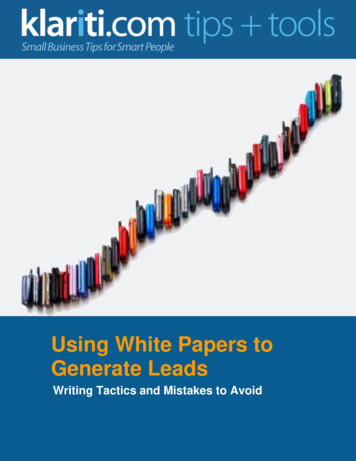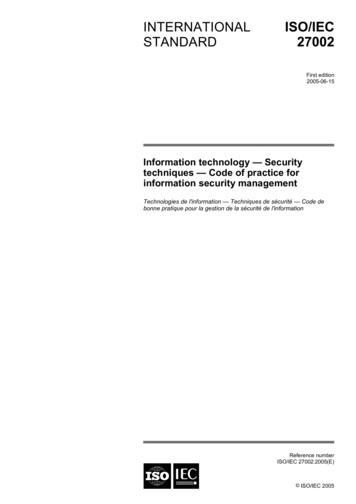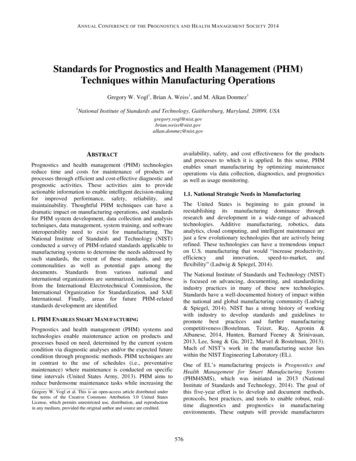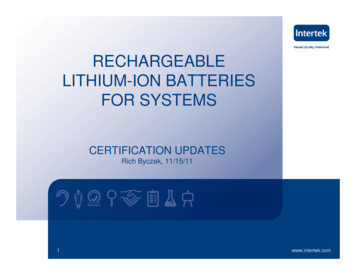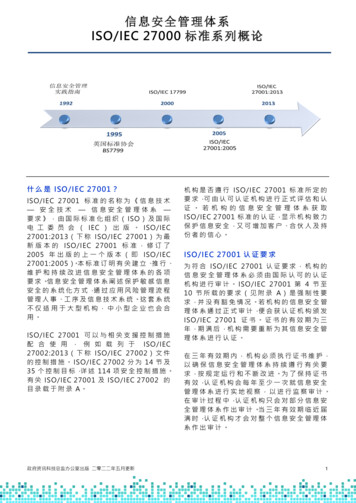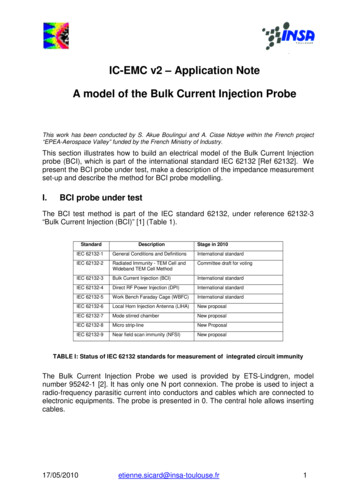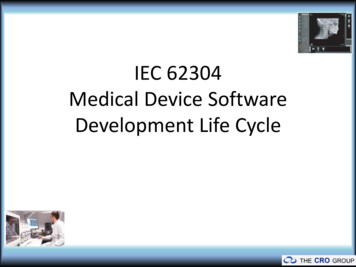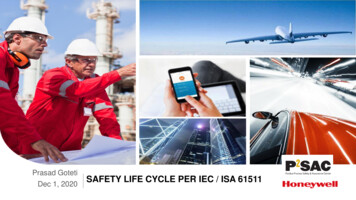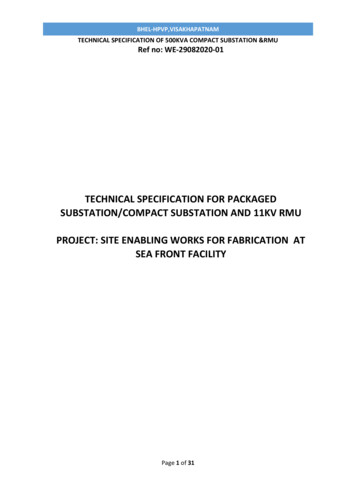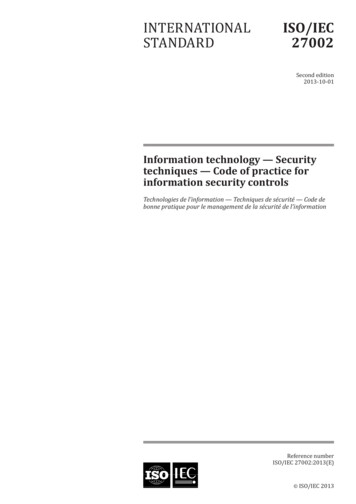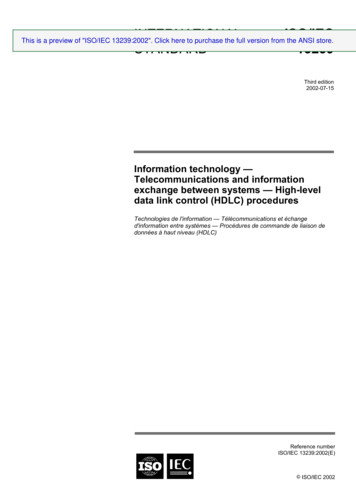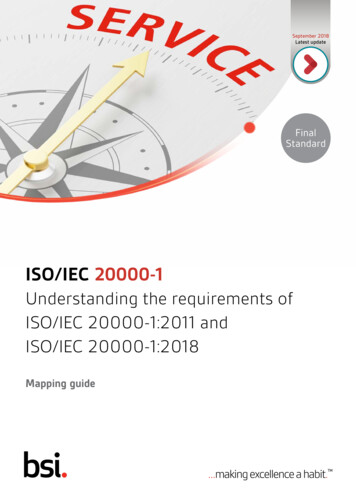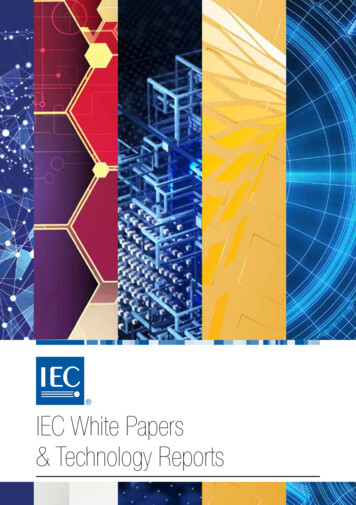
Transcription
IEC White Papers& Technology Reports
White Papers & Technology ReportsEvery year, the IEC publishes one or more white papers or technology reports that ensure that IEC work supportsglobal challenges in electrotechnology. They assess potential worldwide needs and provide recommendations toall relevant stakeholders.The IEC Market Strategy Board (MSB), brings together CTOs of major international companies. It helps identifyfuture technologies and trends of interest, and develops white papers.www.iec.ch2
About the IECKey figures173A global network of 173 countries that covers99% of world population and electricity generationmembers and affiliates 200technical committees20 000Offers an affiliate country programme toencourage developing countries to get involved inthe IEC free of chargeexperts from industry, test and researchlabs, government, academia and consumergroups 10 000Develops international standards and runsfour conformity assessment systems to verify thatelectrical and electronic products work safely andas they are intended tointernational standards published4global conformity assessment systems 1 millionconformity assessment certificates issuedIEC International Standards represent a globalconsensus of state-of-the-art know-how andexpertise 100years of expertiseA not-for-profit organization enabling global tradeand universal electricity access3
Table of contentsAbout the IEC .3Safety in the future .5Semantic interoperability: challenges in the digital transformation age.6Cyber security and resilience guidelines for the smart energy operational environment .7Artificial intelligence across industries .8Stable grid operations in a future of distributed electric power.9Edge intelligence .10LVDC: electricity for the 21st century .11Global energy interconnection .12IoT 2020: Smart and secure IoT platform .13Factory of the future .14Strategic asset management of power networks .15Orchestrating infrastructure for sustainable Smart Cities .16Internet of Things: Wireless Sensor Networks .17Microgrids for disaster preparedness and recovery .18Nanotechnology in the sectors of solar energy and energy storage.19Grid integration of large-capacity Renewable Energy sources and use of large-capacityElectrical Energy Storage.20Electrical Energy Storage.21Coping with the Energy Challenge .224
White PaperSafety in the futureAdvanced robotics, artificial intelligence, theInternet of Things are transforming how humansand electrotechnical systems interconnect. Withthe introduction of new technologies, it is criticallyimportant to ensure that human safety remains at thecentre of the human-machine relationship.Each year, several million workers are injured on thejob. Aside from the economic cost, this is the sourceof immeasurable suffering that is largely preventable.Using real-life examples, this white paper addressessafety in the future by exploring current social trendsand initiatives as well as projects that are pioneeringinnovative safety solutions. All of them are based onthe concept that safety will be integral to systems inwhich humans and machines closely interface. Thepaper also introduces a collaborative framework – thetripartite system for safety – which offers a systematicapproach to examining key safety elements.IEC WP Safety in the future:2020-10(en)White PaperSafety in the futureBringing these safety concepts to fruition willrequire significant standardization efforts to mitigatechallenges related to decision-making involvingmachines and humans.Free download:go.iec.ch/trlvdcThe white paper formulates recommendations bothof a general nature as well as to the IEC community.Printed copy: CHF 50.-The white paper was developed by the IEC MarketStrategy Board (MSB) safety in the future projectteam, directed by Dr Kazuhiko Tsutsumi, MSBConvenor, Mitsubishi Electric Corporation, with majorcontributions from the lead project partner, Dr Coenvan Gulijk, TNO, the Netherlands.5
White PaperSemantic interoperability: challenges in the digitaltransformation ageHumans use words, diagrams, images, context, butalso sounds, facial expressions or body language tobe understood. Machines use data and informationmodels as well as algorithms to manipulateinformation, and human concepts need to betranslated for machine use.Due to the exponentially growing number of systemsthat collect, process, and share data, machinesincreasingly need to be able to communicate witheach other without the intervention of humans.This requires increased interoperability in terms ofconcepts, data structures, information models aswell as digital specifications. In addition to enablingdata exchange, so-called semantic interoperabilitydefines the meaning of data without the need foradditional programming. It provides the means for twosystems to understand each other’s conventions andfunctions behind the data and the context in whichit is used. It allows computer systems to exchangedata with unambiguous, shared meaning. Semanticinteroperability will be the key to digitalization and thelatest industrial revolution.White PaperIEC WP Semantic interoperability:2019-10(en) Semantic interoperability: challenges inthe digital transformation ageFree download:go.iec.ch/wpsemanticThis white paper outlines what it takes to achievemachine-to-machine communication and howstandards can provide structures that will allowmachines to interact truly independently.Printed copy: CHF 50.-The white paper was developed by the IEC MarketStrategy Board (MSB) semantic ontologies projectteam with major contributions from Siemens AG andproject partner, Prof. Dr.-Ing. Christian Diedrich, ifake.V. Magdeburg (Germany).6
Technology ReportCyber security and resilience guidelines for the smartenergy operational environmentThe energy business sector is undergoing profoundchanges. The transition to clean energy is underwayand society is increasingly reliant on electrical energy.However, the business environment is more riskyand mounting competition requires the continualimprovement of end-user services.Simultaneously, the energy sector has acceleratedits evolution towards digitalization digitization thusheightening its reliance on cyber assets, includingsystems, controllers and intelligent devices, tomanage the delivery of electrical energy.However, these cyber assets present seriouschallenges and businesses must determine how tocope with the reality of deliberate cyber attacks as wellas how to remain resilient in the face of inadvertentcyber threats arising from personnel mistakes,the complexity of systems, equipment failure andnatural disaster. Energy businesses that traditionallyaddressed only the system engineering process mustnow include cyber security services and technologies.Technology ReportCyber security and resilience guidelines forthe smart energy operational environmentThis IEC Technology Report provides guidelines tohelp executives in the smart energy operationalenvironment understand the necessary cyber securitypolicies, procedures and technologies that need tobe implemented. It was prepared by the task forceon cyber security in the IEC Systems Committee onSmart energy Working Group 3.Free download:go.iec.ch/teccybersecurityPrinted copy: CHF 50.-7
White PaperArtificial intelligence across industriesArtificial intelligence (AI) is continuously makinginroads into domains previously reserved to humans.Robots support workers in the manufacturing sector;digital assistants automate office tasks; intelligentappliances order food based on owners’ preferencesor control lighting and temperature in the home inpreparation of their arrival. Increasingly sophisticatedalgorithms have the potential to help address someof humanity’s biggest challenges. They also bringabout a number of risks and threats that businesses,governments and policy makers need to understandand tackle carefully.This white paper sets the scene for understandingwhere AI stands today and the outlook for the next 5 to10 years. Taking an industrial perspective, it discussesin more detail: smart homes, intelligent manufacturing,smart transportation/self-driving vehicles, and theenergy sector.White Paper IEC WP AI:2018-10(en)Artificial intelligence across industriesIt covers current technological capabilities andprovides a detailed description of some of the majorexisting and future challenges related to safety,security, privacy, trust and ethics that AI will haveto address at the international level. AI will becomeone of the core technologies across many differentindustries and standardization will play a critical rolein shaping its future.Free download:go.iec.ch/wpaiPrinted copy: CHF 50.-The white paper was developed by the IEC MarketStrategy Board (MSB) with major contributions fromHaier Group and project partner the German ResearchCentre for Artificial Intelligence (DFKI). Supportingproject team members included SAP, Huawei,NSW Data Analytics Centre (DAC), China ElectronicStandardization Institute (CESI), LG Electronics, andKorea Electric Power Corporation (KEPCO).Also available in Chinese8
White PaperStable grid operations in a future of distributedelectric powerIncreasingly, electricity is generated outside of bigpower plants, for example through solar panels, smallwind turbines or small hydro, and usually close towhere it is consumed. When more energy is generatedthan consumed, surplus energy is fed back into theexisting power network where it can negatively affectgrid stability. Unlike with traditional power generation,these additional resources are often invisible to gridoperators, who are unable to predict and control whenenergy is fed back into the network.This white paper explores the driving factors behinddecentralized power generation. It explores futuregrid models and technology solutions that will allowgrid operators to ensure grid stability and ensurecleaner, affordable and reliable power. It also providesrecommendations to industry leaders, policy makersand the IEC community.White PaperIEC WP Stable grid:2018-10(en) Stable grid operations in a future ofdistributed electric powerThe white paper was prepared by the IEC MarketStrategy Board (MSB) advanced network operationproject team with major contributions from TokyoElectric Power Company (TEPCO) and projectpartner GridOptimize. Supporting contributions camefrom Huawei Technologies, FZSONICK SA, WasedaUniversity, Toshiba Energy Systems & Solutions, andState Grid Corporation of China (SGCC).Free download:go.iec.ch/wpstablegridPrinted copy: CHF 50.-9
White PaperEdge intelligenceTo enable and realize the true value of the internet ofthings (IoT), edge intelligence pushes processing fordata intensive applications away from the core of thecloud to the edge of the network.This radical transformation from the cloud to theedge, edge intelligence, will support trillions ofsensors and billions of systems. It will treat data inmotion differently from data at rest.This white paper synthesizes current trends inthe areas of cloud computing, mobile networking,IoT and other domains that require low delay incommunication and decision. Such domains includesmart manufacturing, video analysis for security andsafety, automotive, intelligent city furniture or virtualreality. The publication explores market potential andvertical use case requirements, analyzes gaps andproduces recommendations for adopting vertical edgeintelligence technologies.White PaperIEC WP Asset Management:2015-10(en) Edge intelligenceThe white paper was developed by the IEC MarketStrategy Board (MSB) edge intelligence projectteam with major contributions from Huawei andthe Fraunhofer Institute for Open CommunicationsSystems FOKUS.Free download:go.iec.ch/wpedgeintelligencePrinted copy: CHF 50.Also available in Chinese and Korean10
Technology ReportLVDC: electricity for the 21st centuryLow voltage direct current (LVDC) is a disruptivetechnology that fundamentally accelerates energyaccess and improves energy efficiency. LVDCapplications are many and varied, and can be appliedin every country in the world.In developed economies, the main drivers for the useof LVDC are the improvement of energy efficiency andpower quality as well as the conversion to renewableenergy.In developing economies, the standardization ofvarious aspects of LVDC is likely to have a profoundimpact by facilitating electricity access in even theremotest of villages.Technology ReportThis technology report examines LVDC in termsof market potential, access to energy, voltagestandardization, safety and other key considerations.It pools the collective expertise and know-how ofexperts from all around the world.LVDC: electricity for the 21 centurystFree download:go.iec.ch/trlvdcPrinted copy: CHF 50.-11
White PaperGlobal energy interconnectionEnergy is central to nearly every major challenge andopportunity the world faces. However, one fifth of theworld population still lacks access to energy.The interconnection of grids would open up anunprecedented opportunity to globally share theresources of the whole planet, bringing clean energyto everybody, everywhere in the world.Global energy interconnection (GEI) is technicallyhighly complex. It will require a level of dependabilitynever seen before. International Standards inherentlycontain solutions that will help pre-address thiscomplexity and they play a crucial role in masteringdependability upfront.White PaperThis white paper aims to assess the worldwideneeds, benefits, policies and preconditions for GEI.It examines the readiness of potential markets andidentifies technical and business trends as well ashurdles. It analyzes and compares several globaltransmission scenarios and evaluates their impacton energy supply, the environment, technologies,policies as well as standards development, providingrecommendations to all stakeholders. IEC WP GEI:2016-10(en)Global energy interconnectionFree download:go.iec.ch/wpgeiThe white paper was prepared by the IEC MarketStrategy Board (MSB) global energy interconnectionproject team with major contributions from theInternational Energy Agency (IEA) and State GridCorporation of China (SGCC).Printed copy: CHF 50.Also available in Chinese, Korean and Russian12
White PaperIoT 2020: Smart and secure IoT platformThe Internet of Things (IoT) is an infrastructureof interconnected objects, people or systemsthat processes and reacts to physical and virtualinformation. IoT collectively uses today’s internetbackbone to connect things using sensors and othertechnologies. Through data collection and analysis itachieves a multitude of outcomes that generally aimto improve user experience or the performance ofdevices and systems.How data is collected and implemented will determinehow transformational IoT can become. Security growsexponentially in importance as devices that wereonce isolated become interconnected and more andmore information is collected. As with most disruptivetechnologies solutions are developed by a wide rangeof providers promoting their proprietary approacheswhich can also impact interconnectivity. Bringingthe ambitious visions expressed by IoT to reality willrequire significant efforts in standardization.White PaperIEC WP IoT Platform:2016-10(en) IoT 2020: Smart and secure IoT platformThis white paper aims to provide an overview oftoday’s IoT, including its limitations and deficienciesin the area of security, interoperability and scalability.It contains use cases that point to requirements forsmart and secure IoT platforms. It also discusses nextgeneration platform-level technologies and providesimportant recommendations to IoT stakeholders andfor IoT standardization work.Free download:go.iec.ch/wpiotplatformPrinted copy: CHF 50.Also available in Chinese and KoreanThe white paper was prepared by the IEC MarketStrategy Board (MSB) IoT 2020 project team withmajor contributions from SAP and the FraunhoferInstitute for Applied and Integrated Security AISEC.13
White PaperFactory of the futureWhat will manufacturing look like in the future? Howwill humans and machines communicate with eachother? Will our work environment adapt to our needs?In the factory of the future humans will have to cometo terms with an increasing complexity of processes,machines and components. This will require newoperating concepts for optimized human-machineinteraction.Nimble, adaptive and intelligent manufacturingprocesses will be the measure of success. Thecombination of “virtual” and “real” in order to get a fullview of the complete value chain will allow factoriesto produce products more rapidly, more efficiently andwith greater return using fewer resources.White PaperIEC WP Future Factory:2015-10(en) This white paper will assess the potential worldwideneeds, benefits, concepts and pre-conditions for thefactory of the future. It identifies the business trendsin related technologies and markets, as well as theirimpact on data, people, technologies and standards.Factory of the futureThe white paper was prepared by the IEC MarketStrategy Board (MSB) factory of the future projectteam in cooperation with the Fraunhofer Institute forManufacturing Engineering and Automation IPA.Free download:go.iec.ch/wpfuturefactoryPrinted copy: CHF 50.Also available in Korean and Russian14
White PaperStrategic asset management of power networksWorldwide, the electricity industry is facing a numberof very significant challenges, and the first of these,listed by many electricity network business CEOs, isasset management.While power networks in developed nations strugglewith an equipment base nearing the end of itslifetime, those in developing countries wrestle withtrying to identify best-practice examples to modeltheir operations on. This is taking place against abackground of changing regulatory environments,climate change, evolving consumer behaviour andnew market dynamics.The current lack of international standards orguidelines on asset management for electricalnetworks will have a significant impact on thereliability and future viability of the electricity sector.White PaperIEC WP Asset Management:2015-10(en) Strategic asset managementof power networksThis white paper explores this issue in depth. Itexamines asset management in the electricitypower network sector and identifies areas of assetmanagement practice that could benefit frominternational standards.Free download:go.iec.ch/wpassetmanagementThe white paper was prepared by the IEC MarketStrategy Board (MSB) project team on strategicasset management of power networks with supportfrom N.OGEE Consultants after extensive industryconsultation. Three international workshops, heldaround the world, were attended by electricity networkbusinesses, equipment manufacturers, researchinstitutions and other standards organizations.Printed copy: CHF 50.Also available in Chinese, Korean and Russian15
White PaperOrchestrating infrastructure for sustainable Smart CitiesBy 2050, it is projected that 67% of the globalpopulation will live in cities. Smart cities are necessaryto reduce emissions and to handle this rapid urbangrowth.However cities, as we know them, are faced with acomplex challenge – the traditional processes ofplanning, procuring and financing are not adequatefor the needs of smart cities. Their developmentrequires the right environment for smart solutions tobe effectively adopted and used.Electricity is core in any urban infrastructure systemand the key enabler of cities development, so IEC hasa specific role to play in the development of smartcity standards. Delivering the full value of standards toaccelerate the development of smart cities and lowerits costs also clearly needs a strong collaboration ofall city stakeholders.White PaperIEC WP Smart Cities:2014-11(en) Orchestrating infrastructurefor sustainable Smart CitiesThis white paper explains what is needed to movecities to greater smartness; the what, who andhow of smart city development. It calls for a widecollaboration between many stakeholders, includingother international standardization bodies to ultimatelylead to integrated, cost-efficient, and sustainablesolutions.Free download:go.iec.ch/wpsmartcitiesPrinted copy: CHF 50.-The white paper was prepared by the IEC MarketStrategy Board (MSB) project team on smart citiesin cooperation with the Centre for European PolicyStudies (CEPS).Also available in Chinese, Korean and Russian16
White PaperInternet of Things: Wireless Sensor NetworksWireless sensor networks (WSN) are generatingincreasing interest from industry and research. This isdriven by the availability of inexpensive, low-poweredminiature components such as processors, radios andsensors which are sometimes integrated on a singlechip.The idea of the Internet of Things (IoT) developed inparallel to WSNs. While IoT doesn’t assume a specificcommunication technology, wireless communicationtechnologies will play a major role in the roll-out ofIoT. WSNs will drive many applications and manyindustries.This white paper discusses the use and evolution ofWSNs in the wider context of IoT. It provides a reviewof WSN applications, infrastructures technologies,applications as well as standards that apply to WSNdesigns.White Paper Internet of Things:Wireless Sensor NetworksThe white paper was prepared by the IEC MarketStrategy Board (MSB) wireless sensor networksproject team in cooperation with the US NationalInstitute of Standards and Technology (NIST).Free download:go.iec.ch/wpiotwsnPrinted copy: CHF 50.Also available in Korean and Russian17
White PaperMicrogrids for disaster preparedness and recoveryWhile they are often seen as a means of encouragingthe take up of renewable energy and addressingchallenges of peak demand, microgrids can make asignificant contribution to disaster preparedness andrecovery.This white paper considers preparation for andrecovery from major electricity outages, with afocus on customer-side measures. It examines howdisaster preparedness and post disaster recovery maybenefit from standards and the design of plans forcoordinated activity.Microgrids are a solution to many of the issuesidentified in the disaster review. By relying on a varietyof generators, a microgrid system avoids many ofthe single-point-of-failure issues of the traditionalelectricity grid. Key suggestions encourage theoperation of microgrids and the implementation ofstandards to assist disaster relief planning. Businessand electricity continuity planning as well as electricitycontinuity systems are examined as solutions fordisaster preparedness and recovery.White paperIEC WP Microgrids:2014-03(en) Microgrids for disasterpreparedness and recoveryWith electricity continuity plans and systemsFree download:go.iec.ch/wpmicrogridsThe white paper was prepared by the IEC MarketStrategy Board (MSB) project team on microgriddisaster preparedness and recovery in cooperationwith the Commonwealth Scientific and IndustrialResearch Organisation of Australia (CSIRO) and theJapanese National Institute of Advanced IndustrialScience and Technology (AIST).Printed copy: CHF 50.Also available in Korean18
Technology ReportNanotechnology in the sectors of solar energy andenergy storageNanotechnology brings significant benefits to energystorage and the overall solar energy sector forexample in terms of improved materials’ efficiencyand reduced manufacturing costs. Concretely, batterystorage capacity could be increased, solar cells couldbe produced cheaper and their lifetime extended.This technology report outlines a whole range ofnanomaterials and nanotechnologies, evaluating theirrole in addressing the energy challenge. Notably, itdiscusses their potential contribution to the successfulintegration of renewable energy and energy storage.The publication is intended for manufacturers ofproducts for energy generation and storage as well asfor energy regulators.IEC TR Nanotechnology:2013-10(en)Technology ReportThe technology report was prepared by the IEC MarketStrategy Board (MSB) together with the FraunhoferInstitute for Systems and Innovation Research ISI.Nanotechnology in the sectors ofsolar energy and energy storageFree download:go.iec.ch/trnanotechnologyPrinted copy: CHF 50.-19
White PaperGrid integration of large-capacity Renewable Energysources and use of large-capacity Electrical Energy StorageThe proportion of renewable energies is likely toincrease in all major electricity markets. Their largescale incorporation into existing electricity grids willbe complex, and their successful integration will likelydepend on large-capacity electrical energy storage.This white paper’s primary goal is to provide a globalview on the current state and future directions forgrid integration of large-capacity renewable energysources and the application of large-capacity energystorage for that purpose. It identifies challengesfor grid operators and producers of electricity, andprovides insights into current and potential methodsfor addressing these difficulties. The publication aimsto support grid integration efforts around the worldby providing guidance to the electric utility industry,policy makers and the IEC standardization andconformity assessment community.White PaperIEC WP RE-EES:2012-10(en) Grid integration of large-capacityRenewable Energy sources and use oflarge-capacity Electrical Energy StorageThe white paper was prepared by the IEC MarketStrategy Board (MSB) in cooperation with theRenewable and Sustainable Energy Institute (RASEI) atthe University of Colorado at Boulder (CU-Boulder) andthe National Renewable Energy Laboratory (NREL),and State Grid Corporation of China (SGCC).Free download:go.iec.ch/wpreeesPrinted copy: CHF 50.Also available in Chinese and Korean20
White PaperElectrical Energy StorageThe need for electrical energy storage (EES) willincrease significantly over the coming years. With thegrowing penetration of wind and solar, surplus energycould be captured to help reduce generation costsand increase energy supply.EES will play an important role in maintaining acontinuous and flexible power supply, while balancingthe grid, integrating remote and distributed energygeneration and meeting varying demands. Thiswhite paper identifies the challenges and outlinesavailable technologies. It includes recommendationson research, regulation and standardization.The white paper was prepared by the IEC MarketStrategy Board (MSB) electrical energy storage projectteam in cooperation with the Fraunhofer Institute forSolar Energy ISE and other leading experts.White PaperIEC WP EES:2011-12(en) Electrical Energy StorageFree download:go.iec.ch/wpeesPrinted copy: CHF 50.Also available in Korean21
White PaperCoping with the Energy ChallengeThe IEC’s role from 2010 to 2030Energy consumption will double between now and2030, electricity demand will triple by 2050. Today,large amounts of energy are wasted. Proven, existingtechnologies can bring immediate savings of upto 30% with low hanging fruit in transportation,buildings, cooling and heating or industrial electricalmotors. To reduce emissions and produce enoughenergy for developed and developing nations, the IECbelieves that the whole energy chain will need to berethought.This white paper identifies the challenges and outlinescurrent and future technologies that will help improveenergy efficiency. It provides insights into how theenergy challenge needs to be addressed and includesrecommendations for regulation and standardization.White PaperIEC WP Energy Challenge:2010-09(en) The white paper was prepared by the IEC MarketStrategy Board (MSB) special working group onelectrical energy efficiency in cooperation with leadinginternational experts.Coping with the Energy ChallengeThe IEC’s role from 2010 to 2030Smart electrification - The key to energy efficiencyFree download:go.iec.ch/wpenergychallengePrinted copy: CHF 50.Also available in Chinese, French and Korean22
23
3 rue de VarembéT 41 22 919 0211PO Box 131info@iec.chCH-1211 Geneva 20www.iec.chSwitzerland Registered trademark of the International Electrotechnical Commission. Copyright IEC, Geneva, Switzerland. 2020.IEC WPs TERs:2020-11(en) InternationalElectrotechnicalCommission
The white paper formulates recommendations both of a general nature as well as to the IEC community. The white paper was developed by the IEC Market Strategy Board (MSB) safety in the future project team, directed by Dr Kazuhiko Tsutsumi, MSB Convenor, Mitsubishi Electric Corporation, with major contributions from the lead project partner, Dr Coen
